The Best Wi-Fi Cards for PCs and Laptops in 2024
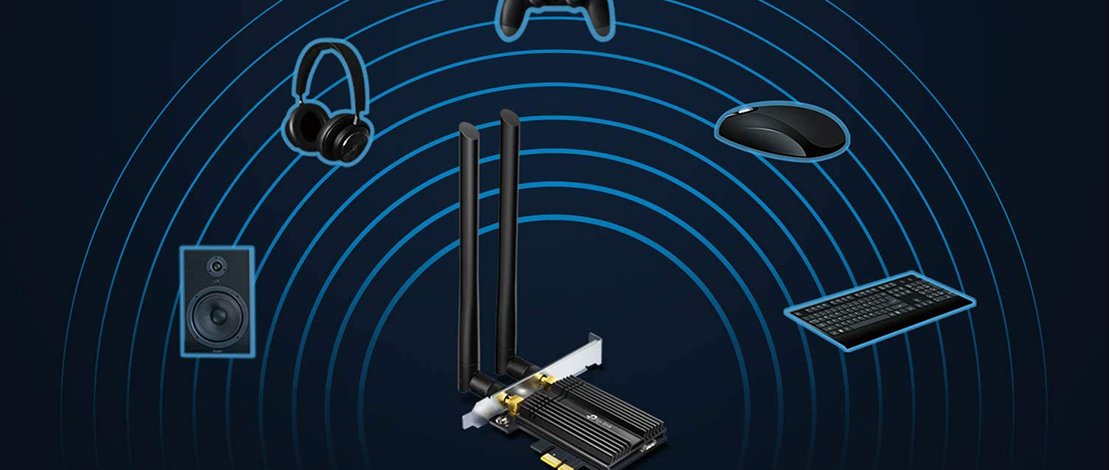
If you want a quick and easy way to enable wireless connectivity on your computer you can either get a USB Wi-Fi adapter or a Wi-Fi card. Both solutions are relatively simple to install, although the latter one requires users to open their PC case. But, that’s not so complex of operation as it may seem as. The thing is, the market is crowded with all kinds of Wi-Fi cards. Finding the best Wi-Fi card can be a drag so why don’t you check out this list instead?
We have the best Wi-Fi cards for PC right here. Below, you’ll find best Wi-Fi 6 cards, cards that feature fast speeds and long ranges (perfect to combine with a long-range Wi-Fi router), as well as both PCIe and M.2 Wi-Fi cards. And once you finish reading the list, check out our Wi-Fi card buying guide. It has lots of helpful info regarding Wi-Fi cards. And now, let’s check the best PCIe Wi-Fi cards and the best M.2 Wi-Fi cards you can find right now.
Best Wi-Fi Cards
TP-Link Archer TXE72E
WiFi 6E on a Budget
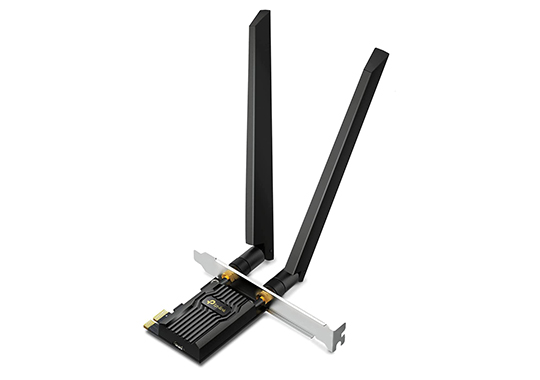
- WiFi 6E PCIe Card
- Bluetooth 5.3
- MU-MIMO and OFDMA
- Speeds up to 2.4 Gbps
- WPA3
If your motherboard does not natively support WiFi connections, getting a PCIe WiFi expansion card is a solid option to extend your network capabilities. The TP-Link Archer TXE72E is a WiFi 6E network adapter which is the latest tech available currently.
This device is capable of 2.4 Gbps (2402 Mbps in 6GHz, 2402 Mbps in 5 GHz, or 574 Mbps in 2.4 GHz) with ultra-low latency while using MU-MIMO and OFDMA. The Archer TXE72E is also capable of Bluetooth 5.3 so you can have a broad and fast Bluetooth connection as well besides fast WiFi.
Finally, the device is also WPA3 secured which means information being sent by your network is protected from hackers allowing for a fast and safe network for your gaming and office needs.
- Low-profile bracket and small device that can fit in most builds without issues
- 2 solid antennas for WiFi 6E speeds
- The fact that the device has Bluetooth as well makes it a great 2-in-1 device
- Greater security with WPA3
- WiFi speeds are great but it seems that the Bluetooth connection is iffy
ASUS WiFi 6E PCE-AXE58BT
Solid WiFi 6E Experience
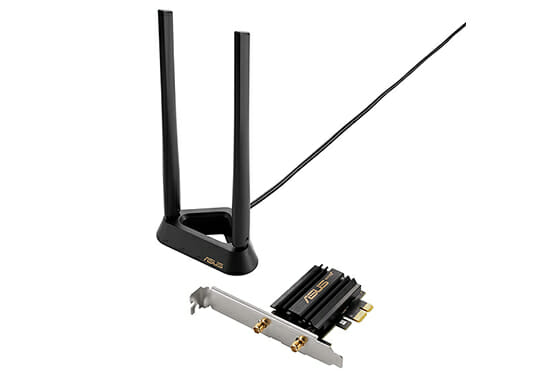
- WiFi 6E
- Bluetooth 5.2
- 6GHz band connectivity
- External antennas for a broader range
If your motherboard did not come with WiFi or Bluetooth compatibility a quick fix for that is buying an extra PCI-E expansion card that can offer you both. The Asus offering on the market allows you to achieve WiFi 6E which is the fastest network standard currently available.
You will be able to use the dedicated 6GHz band for less congestion and faster speeds on your main PC. The expansion card also comes with Bluetooth 5.2 which is also the latest tech and allows for improved signal range and performance with less interference from other devices.
As with most expansion cards you also get two external antennas which will help you with WiFi dead zones in your house.
- Allows for the fastest internet speeds
- The newest Bluetooth standard is used
- Can be used with any PCI-E slot
- The extra antennas allow for a stronger signal
- The Bluetooth connection might be finicky with this device
- Driver issues seem to happen in certain situations
GIGABYTE WiFi 6E GC-WBAX210
Experience Gigabit Internet on WiFi
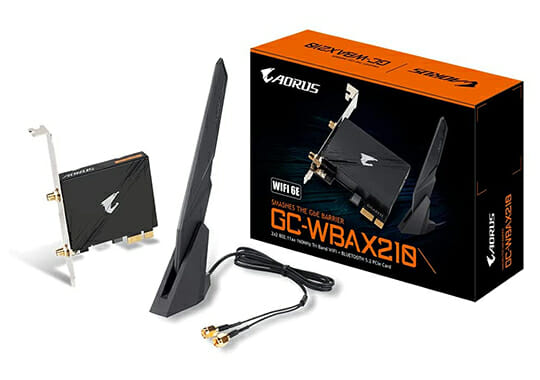
- WiFi 6E
- Bluetooth 5.2
- Tri-Band WiFi AX210 chip
- Up to 2400 Mbps
WiFi seems quite finicky compared to a solid Ethernet connection and while that still holds even with an expansion card, this Gigabyte GC-WBAX210 WiFi card gets pretty close to wired internet while using WiFI 6E.
This expansion card is using an Intel AX210 module which unlike the AX200 module is tri-band so it can support 2.4GHz, 5GHz, and 6GHz. The 6GHz is a high bandwidth separate channel for that up to 2400 Mbps experience.
Besides the fast and reliable WiFi, the card offers Bluetooth 5.2 which is the fastest version available right now.
Overall the 2×2 802.11ax/Tri-Band WiFi seems to be rock solid on this Gigabyte card and unlike other expansion cards is pretty straightforward to set up and use.
- Well build device
- Stable WiFi and Bluetooth connection without drops
- Pretty easy to get it going with the drivers from the Gigabyte site
- The antenna has a magnetic base
- You will need a free power header on your motherboard otherwise you will need to buy a splitter
Ubit AX200
Excellent Budget Wi-Fi PCIe Card With Wi-Fi 6 Support
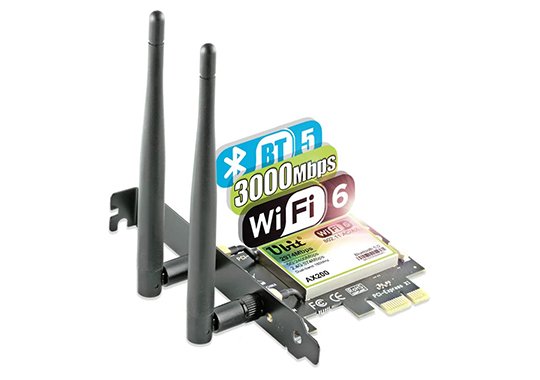
- Wi-Fi Support: Up To Wi-Fi 6
- Dual-Band: Yes
- Max Bandwidth: Up To 2402Mbps (5Ghz); Up To 574Mbps (2.4Ghz)
- OS Compatibility: Windows 10, Linux, Chrome OS
The AX200 from Ubit is another Wi-Fi 6 PCIe card with fast speeds and an affordable price. This card offers full Wi-Fi 6 support including Wi-Fi 6 exclusive features such as OFDMA or TWT. The two antennas that come with this card can only be mounted directly on the card.
Since there’s no antenna base you won’t be able to tweak the position of the antennas to get a better signal. This is why we cannot recommend this card to hardcore gamers. In order to get the best gaming experience, they have to be able to move the antenna around and they cannot do this with this card.
But everyone else should definitely check out this card. It has excellent performance that’s advertised as up to 2402 Mbps on the 5GHz band and up to 574Mbps over the 2.4Ghz band. User reviews mention that the card can top out gigabit internet plans, with speed reaching around 900Mbps.
This is an excellent result, in line with more expensive Wi-Fi 6 cards. On top of its excellent performance, the AX200 also comes with Bluetooth 5.1 support, which brings a number of updates over Bluetooth 5.0. Overall, this is another great budget Wi-Fi card that can reach very fast speeds thanks to its Wi-Fi 6 support.
- Great Performance For The Price
- Bluetooth 5.1 Support
- There’s No Portable Antenna Base In The Package
TP-Link Archer TXE75E
Flawless TP-Link Experience
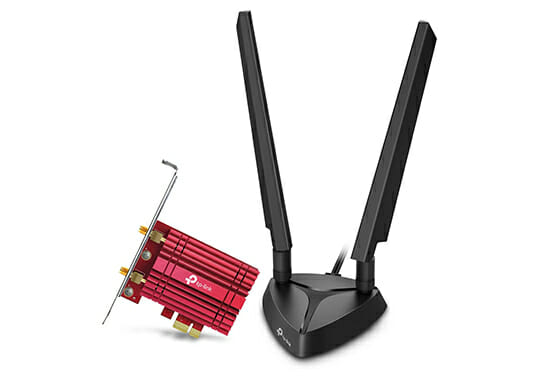
- WiFi 6E standard
- Bluetooth 5.2
- WPA3 security
- OFDMA and MU-MIMO technology
People buy TP-Link devices because when it comes to networking these are known to be pretty much the standard. In the case of the Archer TXE75E expansion card, the same can be said – a solid networking experience without any hiccups.
The expansion card uses the WiFi 6E standard and has Tri-Band compatibility with 2.4GHz, 5GHz, and 6GHz bands. To make full use of your 6E router you should be using your 6GHz dedicated band for the lowest latency and highest (up to 2400Mbps) speeds.
Besides better network coverage the TP-Link device also enables your PC to connect to Bluetooth devices with Bluetooth 5.2 for the fastest and most reliable experience. The device also comes packed with extra features like OFDMA and MU-MIMO technology for lower lag on your network.
The expansion card is also well built with a heatsink, magnetic base for the antennas, and a low-profile bracket to fit into smaller builds. A solid choice from TP-Link as always.
- No recorded drops in signal for the WiFi or Bluetooth
- Uses the latest technology for your connections
- Wider signal with the included antennas
- Low-profile bracket for smaller builds
- To use the 6GHz band you will need to be using Windows 11
Intel Network AX200.NGWG.NV
The Best M.2 Wi-Fi Card
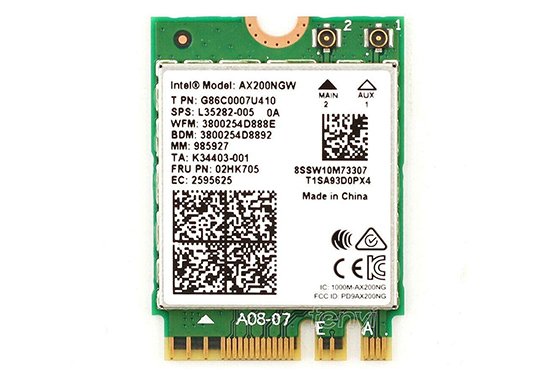
- Wi-Fi Support: Up To Wi-Fi 6
- Dual-Band: Yes
- Max Bandwidth: Up To 2402Mbps
- OS Compatibility: Windows 10, Linux, Chrome OS
The AX200 Wi-Fi chip from Intel can be installed into any laptop or desktop PC with a dedicated M.2 slot for a Wi-Fi card. It features the A+E M.2 key and should fit into any M.2 slot dedicated for a Wi-Fi card. These slots can be found on some desktop motherboards as well as in most modern laptops.
Now, this card supports Wi-Fi 6 and Bluetooth 5.1 connection, which is great for the price. The downside is that if you plan on installing it on a desktop PC get ready to find and install some external antennas, which shouldn’t be too hard. Once you install the AX200, get ready for fast performance. This card can reach 1Gbps if you have fast enough internet plan, which is awesome for the price.
And since external Wi-Fi antennas can be found at very low prices you can build a very fast Wi-Fi chip + antenna combo for cheap. Still, if you own a desktop PC we would rather recommend a regular, PCIe Wi-Fi card. There are excellent cards on this list with Wi-Fi 6 support, great performance and range, and low price. But if you own a laptop, this card is a no brainer recommendation. It’s very fast, it sports an extremely affordable price, and it should fit inside most modern laptops.
- Very Affordable
- Excellent Performance
- Supports Wi-Fi 6
- Can Fit Most Modern Laptops
- Installation On A Desktop PC Can Be Tricky
OKN WiFi 6E AX210
M.2 6E WiFi Card
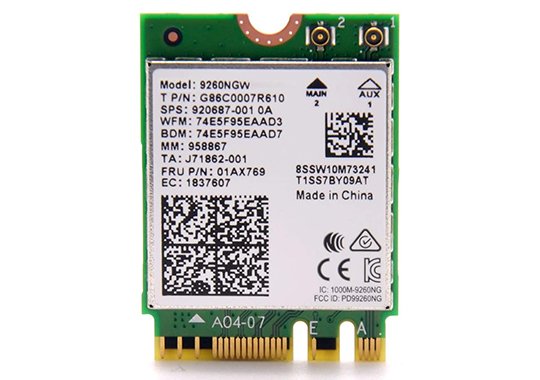
- M.2 slot expansion card
- WiFi 6E and Bluetooth 6.2
- WPA, WPA2, and WPA3 network security
- MU-MIMO, 1024QAM, OFDMA, 160MHz
If instead of a PCI-E card you want to use an extra M.2 slot to get better networking then the OKN expansion card is the perfect choice for you.
This is a WiFi 6E card with all the bells and whistles like Tri-Band support (574 Mbps – 2.4GHz, 2400 Mbps – 5GHz, 2400Mbps – 6GHz) MU-MIMO, 1024QAM, OFDMA, 160MHz, etc. This is all possible because the device uses an AX210 Intel chip which has the newest network technology.
Your PC will also benefit from Bluetooth 5.2 connectivity with the AX210 chip allowing for lower latency and better coverage. To make use of all of these features you will need to be using Windows 10 and have a newer AMD/Intel CPU which is compatible with all of these technologies.
- Compatible with laptops/PCs with an open M.2 slot
- Uses the newest AX210 Intel chip for networking
- Solid WiFi and Bluetooth connectivity
- Uses standard Intel drivers for setup
- To make full use of the device you should be using a newer AMD/Intel CPU and Windows 10
How To Choose A Wi-Fi Card
Picking the right Wi-Fi card isn’t that complicated. Just check whether your router supports Wi-Fi 6 and then look either for a card that supports Wi-Fi 5 or Wi-Fi 6. Wi-Fi 6 includes some cool tech that should decrease lag and latency so we recommend a Wi-Fi 6 card and router for all gamers playing over a wireless connection. And no, you don’t have to spend a fortune on a Wi-Fi 6 router since even some sub-$100 routers support Wi-Fi 6.
Next, check user and professional reviews to see the performance and if the card’s fast enough for your internet plan. Remember that M.2 cards’ performance is relative since it depends on the antennas found in different laptop models and different external antennas on desktop PCs. Then, read our USB Wi-Fi adapter buying guide. It’s filled with helpful data for everyone looking for a Wi-Fi card (just skip the USB-specific stuff). And finally, read on about specific things to look out for when buying a PCIe or M.2 Wi-Fi card below.
M.2 Wi-Fi Cards Require A Dedicated M.2 Slot, Except In One Case
Unlike PCIe Wi-Fi cards, which are reserved for desktop computers, M.2 Wi-Fi cards can be installed both on desktop and laptop computers. But, they require a dedicated M.2 slot to install into. They usually use E key M.2 slots. These can be found on some newer desktop motherboards as well as on most newer laptop models.
You should have a dedicated Wi-Fi M.2 slot listed on the specs page of your motherboard. And, in case of a laptop, you can check whether your Wi-Fi card is using an M.2 slot or it is soldered onto the board. If it uses a dedicated Wi-Fi M.2 slot, you’re good to go.
Another way to make an M.2 Wi-Fi card to work on a desktop is to hook it up to an M.2 to PCIe adapter made specifically for M.2 Wi-Fi cards. This adapter should work with every Intel M.2 Wi-Fi card. This way you can use an M.2 card on a desktop PC that doesn’t have an M.2 slot for a Wi-Fi card.
If Installing An M.2 Card On A Desktop PC Make Sure To Hook It To An External Antenna
If you plan on getting an M.2 card for your desktop PC, make sure to also get an external antenna. M.2 cards on a laptop use its built-in antennas but on the desktop, they will have a very poor range without an antenna.
Luckily, the installation process is painless. First of all, find an external antenna, there are lots of models there and most are quite cheap. Next, follow this tutorial video on how to equip an M.2 card with an antenna. BTW, you should have holes for the antenna connectors on the rear panel armor in case your motherboard has a dedicated Wi-Fi card M.2 slot so don’t worry about that detail.
You Can Install PCIe Wi-Fi Cards On Any PCIe Slot
Since the PCIe ports are modular you don’t have to put the PCIe Wi-Fi card in an x1 PCIe slot. You can use any available PCIe slot on your motherboard. The only one we don’t recommend using is the primary X16 slot reserved for the graphics card.
If You Have Issues With Signal Strength Get A Card With A Portable Antenna Base
A portable antenna base allows users to move it around their desk in order to get a better signal. If your router is across the room of your PC, or if another room, you might have issues with signal strength. It may be blocked by your case or some other object. With a portable antenna base, you can move the antenna away from the case and get a stronger and more reliable Wi-Fi signal.
PCIe Wi-Fi Cards Offer Faster Performance Than USB Cards
In order for your USB port to be faster than an x1 PCIe 3.0 slot (used in PCIe Wi-Fi cards) it has to support the latest, USB 3.2 Gen 2 spec, and those aren’t that common. And if you own an X570 or B500 motherboard, you have PCIe 4.0 PCIe ports there, which are twice as fast as PCIe ports. So, in most cases, PCIe Wi-Fi cards can support faster speeds, in theory, than USB Wi-FI adapters. If you need the best speed, get a PCIe Wi-Fi card.
On the other hand, USB Wi-Fi adapters can also be a better choice, in some cases. For instance, if you have both a desktop and laptop with a broken Wi-Fi chip or two laptops or any other combination that includes multiple computers that need access to a wireless network, getting a USB Wi-Fi adapter is a better choice. You can simply remove it and hook it to another device, swapping it between devices in a second. You can’t do that with PCIe and M.2 Wi-Fi Cards.
Hi will the Intel Network AX200.NGWG.NV work on an AMD laptop?
Hi Elmo. It works with AMD CPUs.